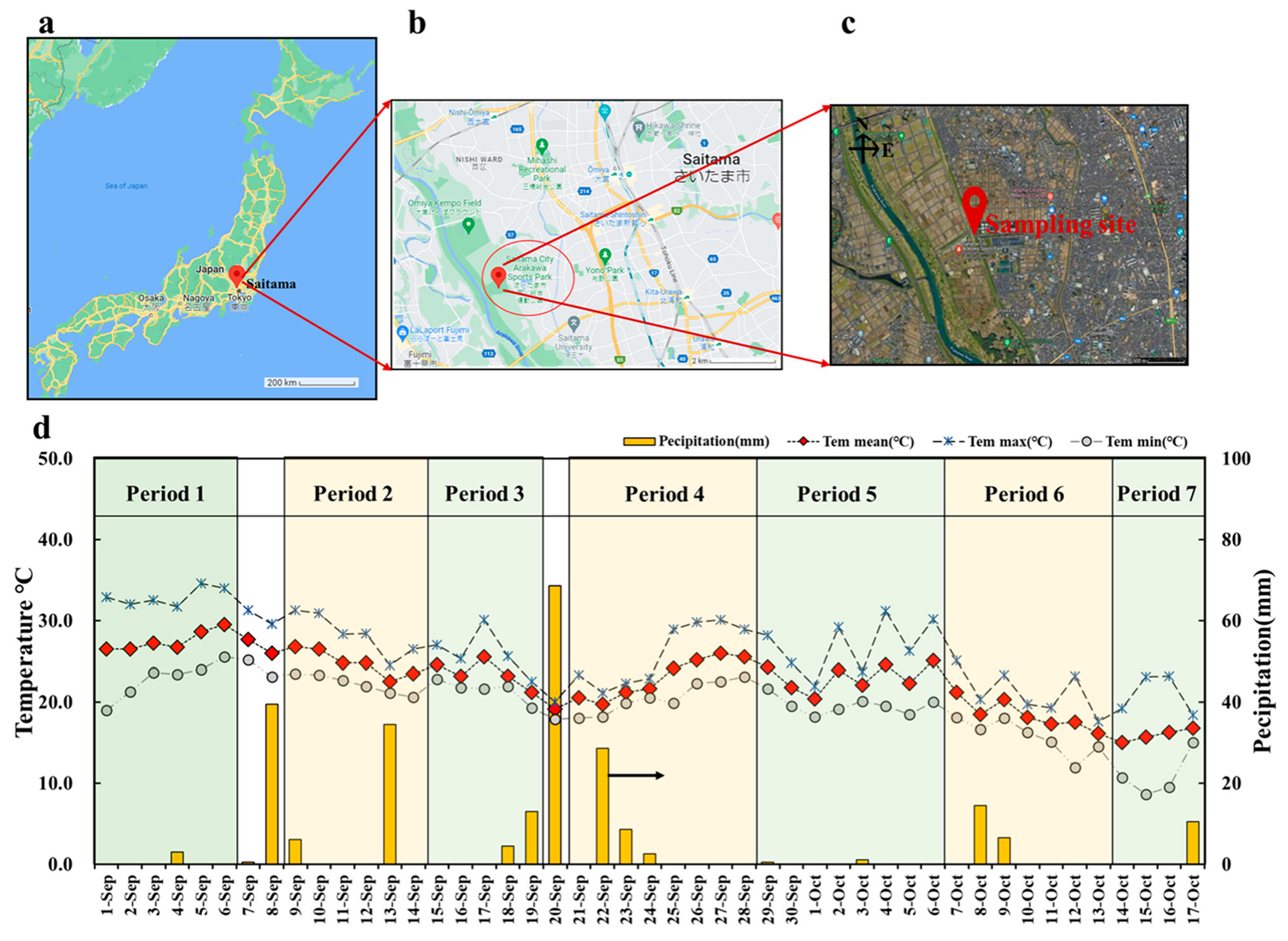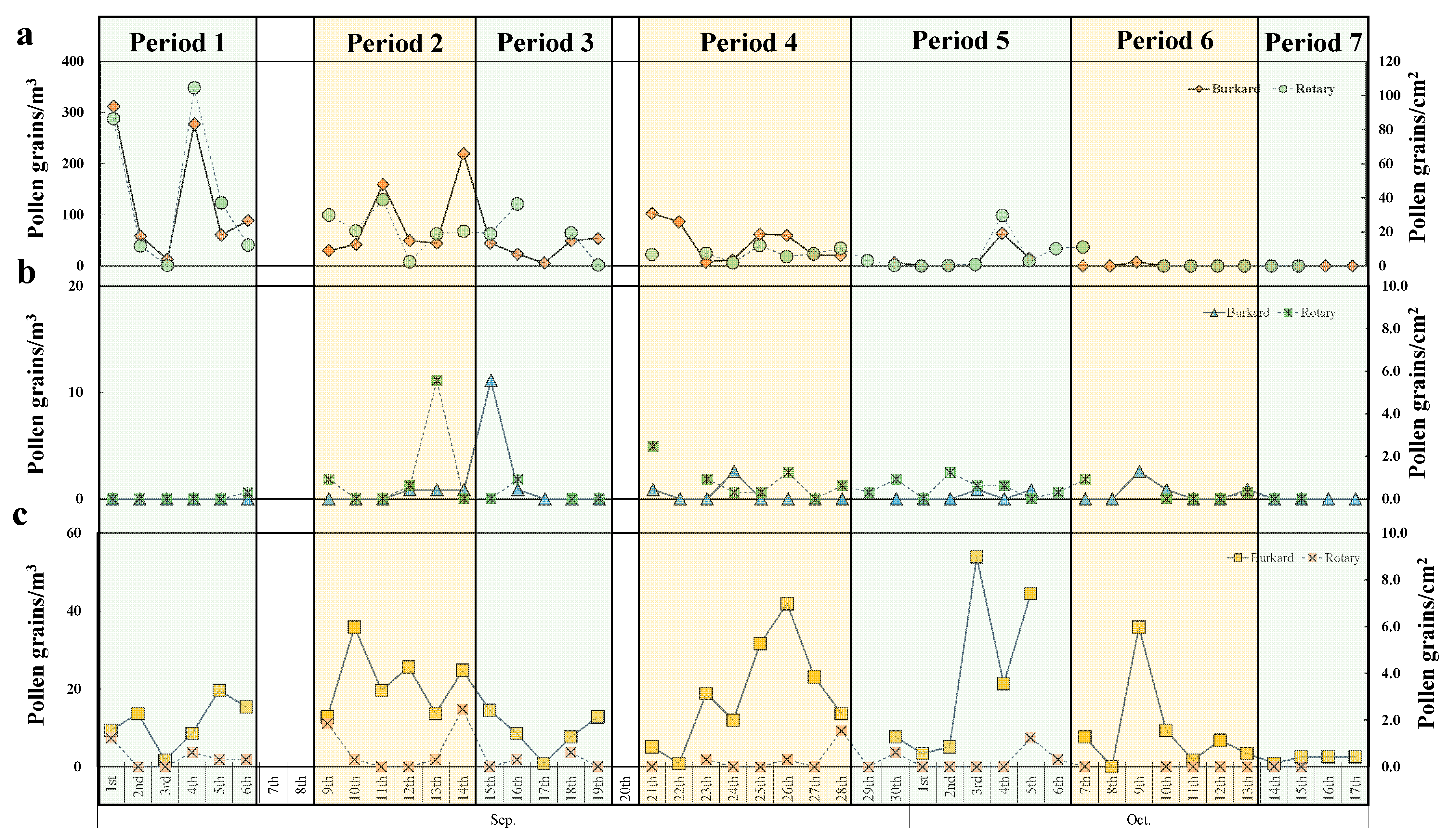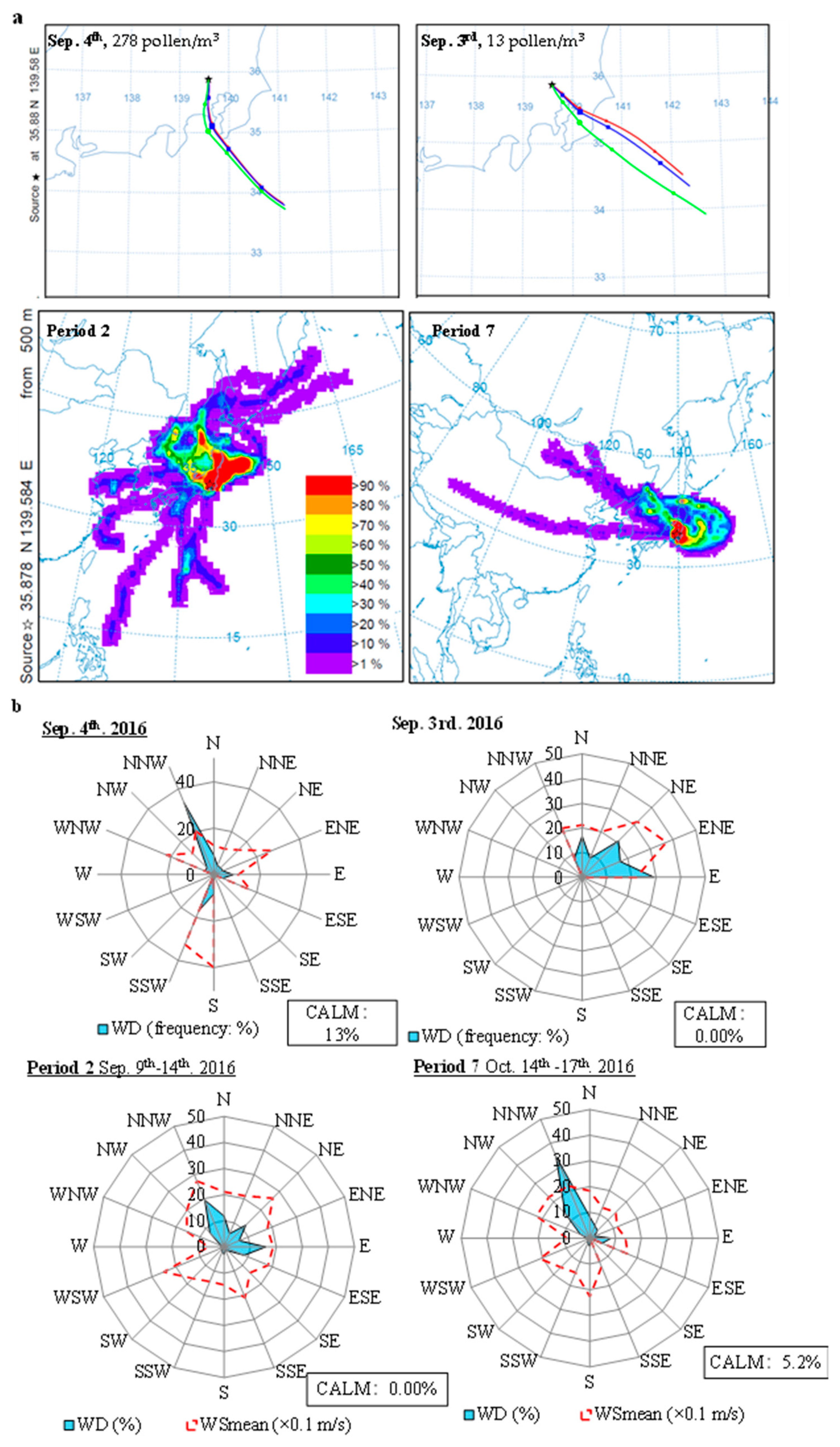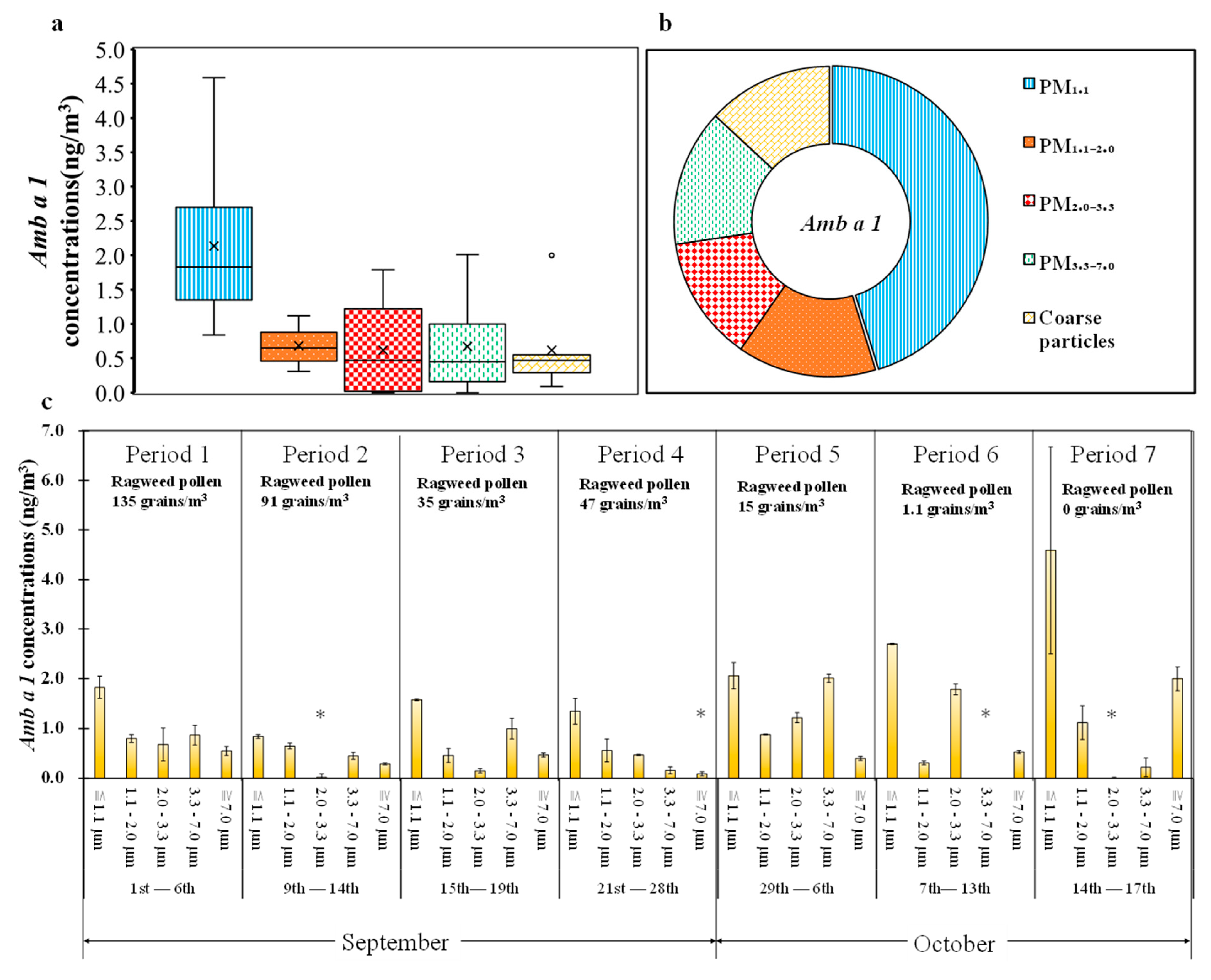Behavior of Autumn Airborne Ragweed Pollen and Its Size-Segregated Allergens (Amb a 1): A study in Urban Saitama, Japan
Abstract
1. Introduction
2. Materials and Methods
2.1. Airborne Pollen and Allergenic Particle Sampling in Saitama
2.2. Observation of Airborne Pollen and Counting Statistics
2.3. Determination of Amb a 1 Concentration Using the SPR Method
2.4. Determination of Water-Soluble Ions and pH in Ambient Particles
2.5. Analysis of Backward Air Mass Trajectories and Data Statistics
3. Results
3.1. Temporary Characterization of three Airborne Herbaceous Pollen
3.2. The Effects of Meteorological and Environmental Factors on the Airborne Dispersion of Ragweed Pollen
3.3. Size and Temporal Distributions of Amb a 1 in the Atmosphere
3.4. Influences of Environmental Factors on Amb a 1 Distribution
4. Discussion
4.1. The Behavior of Autumn Airborne Ragweed Pollen
4.2. Airborne Amb a 1 Distributed in Fine Particles
4.3. Potential Environmental Influence Analysis of Pollen and Amb a 1
5. Conclusions
6. Patents
Supplementary Materials
Author Contributions
Funding
Institutional Review Board Statement
Informed Consent Statement
Data Availability Statement
Acknowledgments
Conflicts of Interest
Abbreviations
| PCC | Pearson correlation coefficient |
| CO2 | Carbon dioxide |
| EDTA | Ethylenediaminetetraacetic acid |
| ELISA | Enzyme-Linked Immunosorbent Assay |
| GDAS | Global Data Assimilation System |
| HEPES | 4-(2-hydroxyethyl)-1-piperazineethanesulfonic acid |
| HYSPLIT | Hybrid Single Particle Lagrangian Integrated Trajectory |
| IC | Ion chromatography |
| NADPH | Nicotinamide adenine dinucleotide phosphate |
| NNW | North-northwest |
| NOAA | National Oceanic and Atmospheric Administration |
| PCA | Principal component analysis |
| PCC | Pearson correlation coefficient |
| PM | Particulate matter |
| PM1.1 | Fine particles with a diameter of 1.1 μm or less |
| PM1.1–2.0 | Fine particles with the particle sizes from1.1 μm to 2.0 μm |
| PM2.0–3.3 | Fine particles with the particle sizes from 2.0 μm to 3.3 μm |
| PM2.5 | Fine particles with the particle sizes equal and below 2.5 μm |
| PM3.3–7.0 | Fine particles with the particle sizes from 3.3 μm to 7.0 μm |
| RU | Resonance unit |
| SCC | Spearman correlation coefficient |
| SEM | Scanning electron microscope |
| SPM | Suspended particulate matter |
| SPPs | Sub-pollen particles |
| SPR | Surface plasmon resonance |
| SSW | South-southwest |
| TSP | Total suspended particulate |
| WD | Wind direction |
| WS | Wind speed |
References
- Makra, L.; Matyasovszky, I.; Hufnagel, L.; Tusnady, G. The history of ragweed in the world. Appl. Ecol. Environ. Res. 2015, 13, 489–512. [Google Scholar]
- Matthew, L.; Oswalt, G.D. Ragweed as an Example of Worldwide Allergen Expansion. Allergy Asthma Clin. Immunol. 2008, 4, 130–135. [Google Scholar] [CrossRef]
- Turkalj, M.; Banic, I.; Anzic, S.A. A review of clinical efficacy, safety, new developments and adherence to allergen-specific immunotherapy in patients with allergic rhinitis caused by allergy to ragweed pollen (Ambrosia artemisiifolia). Patient Prefer. Adherence 2017, 11, 247. [Google Scholar] [CrossRef]
- Chen, K.W.; Marusciac, L.; Tamas, P.T.; Valenta, R.; Panaitescu, C. Ragweed pollen allergy: Burden, characteristics, and management of an imported allergen source in Europe. Int. Arch. Allergy Immunol. 2018, 176, 163–180. [Google Scholar] [CrossRef] [PubMed]
- Horii, M. Why do the Japanese wear masks? Electron. J. Contemp. Jpn. Stud. 2014, 14, 8. [Google Scholar]
- Harrington, J.B., Jr.; Metzger, K. Ragweed pollen density. Am. J. Bot. 1963, 50, 532–539. [Google Scholar] [CrossRef]
- Peternel, R.; Čulig, J.; Hrga, I.; Hercog, P. Airborne ragweed (Ambrosia artemisiifolia L.) pollen concentrations in Croatia, 2002–2004. Aerobiologia 2006, 22, 161–168. [Google Scholar]
- D′amato, G.; Spieksma, F.T.M.; Liccardi, G.; Jäger, S.; Russo, M.; Kontou-Fili, K.; Nikkels, B.W.H.; Bonini, S. Pollen-related allergy in Europe. Allergy 1998, 53, 567–578. [Google Scholar] [CrossRef]
- Alan, Ş.; Sarışahin, T.; Acar Şahin, A.; Kaplan, A.; Pınar, N.M. An assessment of ragweed pollen and allergen loads in an uninvaded area in the Western Black Sea region of Turkey. Aerobiologia 2019, 36, 183–195. [Google Scholar] [CrossRef]
- Grewling, Ł.; Bogawski, P.; Jenerowicz, D.; Czarnecka-Operacz, M.; Šikoparija, B.; Skjøth, C.A.; Smith, M. Mesoscale atmospheric transport of ragweed pollen allergens from infected to uninfected areas. Int. J. Biometeorol. 2016, 60, 1493–1500. [Google Scholar] [CrossRef] [PubMed]
- Zhou, S.; Zhao, H.; Peng, J.; Hong, Q.; Xiao, K.; Shang, Y.; Lu, S.; Zhang, W.; Wu, M.; Li, S.; et al. Size distribution of Platanus acerifolia allergen 3 (Pla a3) in Shanghai ambient size-resolved particles and Its allergenic effects. Atmos. Environ. 2019, 198, 324–334. [Google Scholar] [CrossRef]
- Gong, X.; Wang, Q.; Lu, S.; Suzuki, M.; Nakajima, D.; Sekiguchi, K.; Miwa, M. Size distribution of allergenic Cry j 2 released from airborne Cryptomeria japonica pollen grains during the pollen scattering seasons. Aerobiologia 2016, 33, 59–69. [Google Scholar] [CrossRef]
- Wang, Q.; Gong, X.; Suzuki, M.; Lu, S.; Sekiguchi, K.; Nakajima, D.; Miwa, M. Size-segregated allergenic particles released from airborne Cryptomeria japonica pollen grains during the Yellow Sand events within the pollen scattering seasons. Asian J. Atmos. Environ. 2013, 7, 191–198. [Google Scholar] [CrossRef]
- Wang, Q.; Morita, J.; Gong, X.; Nakamura, S.; Suzuki, M.; Lu, S.; Sekiguchi, K.; Nakajima, T.; Nakajima, D.; Miwa, M. Characterization of the physical form of allergenic Cry j 1 in the urban atmosphere and determination of Cry j 1 denaturation by air pollutants. Asian J. Atmos. Environ. 2012, 6, 33–40. [Google Scholar] [CrossRef]
- Rich, R.L. Higher-throughput, label-free, real-time molecular interaction analysis. Anal. Biochem. 2007, 361, 80018663136. [Google Scholar] [CrossRef] [PubMed]
- Berger, M.; Bastl, K.; Bastl, M.; Dirr, L.; Hutter, H.P.; Moshammer, H.; Gstöttner, W. Impact of air pollution on symptom severity during the birch, grass and ragweed pollen period in Vienna, Austria: Importance of O(3) in 2010–2018. Environ. Pollut. 2020, 263, 114526. [Google Scholar] [CrossRef]
- Wang, Q.; Wang, W. Size characteristics and health risks of inorganic species in PM1. 1 and PM2. 0 of Shanghai, China, in spring, 2017. Environ. Sci. Pollut. Res. 2020, 27, 14690–14701. [Google Scholar]
- Wang, W.; Zhang, W.; Dong, S.; Yonemachi, S.; Lu, S.; Wang, Q. Characterization, pollution sources, and health risk of ionic and elemental constituents in PM2.5 of wuhan, central China. Atmosphere 2020, 11, 760. [Google Scholar]
- Celenk, S. Detection of reactive allergens in long-distance transported pollen grains: Evidence from Ambrosia. Atmos. Environ. 2019, 209, 212–219. [Google Scholar] [CrossRef]
- De Linares, C.; Belmonte, J.; Canela, M.; de la Guardia, C.D.; Alba-Sanchez, F.; Sabariego, S.; Alonso-Pérez, S. Dispersal patterns of Alternaria conidia in Spain. Agric. For. Meteorol. 2010, 150, 1491–1500. [Google Scholar] [CrossRef]
- Erbas, B.; Jazayeri, M.; Lambert, K.A.; Katelaris, C.H.; Prendergast, L.A.; Tham, R.; Parrodi, M.J.; Davies, J.; Newbigin, E.; Abramson, M.J.; et al. Outdoor pollen is a trigger of child and adolescent asthma emergency department presentations: A systematic review and meta-analysis. Allergy 2018, 73, 1632–1641. [Google Scholar] [CrossRef] [PubMed]
- Puc, M.; Wolski, T.; Camacho, I.C.; Myszkowska, D.; Kasprzyk, I.; Grewling, L.; Nowak, M.; Weryszko-Chmielewska, E.; Piotrowska-Weryszko, K.; Chlopek, K.; et al. Fluctuation of birch (Betula L.) pollen seasons in Poland. Acta Agrobot. 2015, 68, 303. [Google Scholar] [CrossRef]
- Puc, M. Ragweed and mugwort pollen in Szczecin, Poland. Aerobiologia 2006, 22, 67–78. [Google Scholar] [CrossRef]
- Marco, M.; Paola, D.M.; Alfonso, C.; Marzia, O.; Simone, O. Long distance transport of ragweed pollen as a potential cause of allergy in central Italy. Ann. Allergy Asthma Immunol. 2006, 96, 86–91. [Google Scholar]
- Jeong, K.Y.; Han, I.S.; Choi, S.Y.; Lee, J.H.; Lee, J.S.; Hong, C.S.; Park, J.W. Allergenicity of recombinant profilins from Japanese hop, Humulus japonicus. J. Investig. Allergol. Clin. Immunol. 2013, 23, 345–350. [Google Scholar]
- Majeed, H.T.; Periago, C.; Alarcón, M.; Belmonte, J. Airborne pollen parameters and their relationship with meteorological variables in NE Iberian Peninsula. Aerobiologia 2018, 34, 375–388. [Google Scholar] [CrossRef]
- Stone, E.A.; Mampage, C.B.; Hughes, D.D.; Jones, L.M. Airborne sub-pollen particles from rupturing giant ragweed pollen. Aerobiologia 2021, 37, 625–632. [Google Scholar] [CrossRef]






| Ragweed (Burkard) | Ambient Amb a 1 | |||||
|---|---|---|---|---|---|---|
| Daily | Event | TSP | PM1.1 | Coarse Particles | ||
| Ragweed (Burkard) | Daily | 1 | --- | --- | --- | --- |
| Event | --- | 1 | −0.53 | −0.58 | −0.38 | |
| Ragweed (Rotary) | 0.83 | |||||
| Amb a 1 | TSP | --- | −0.53 | 1 | 0.88 | 0.77 |
| PM1.1 | --- | −0.58 | 0.88 | 1 | 0.93 | |
| Coarse particles | −0.38 | 0.77 | 0.93 | 1 | ||
| Temperature mean (°C) | 0.41 | 0.87 | −0.52 | −0.73 | −0.58 | |
| RHmean (%) | 0.07 | 0.17 | −0.72 | −0.58 | −0.42 | |
| Daily sunlight (h) | 0.160 | 0.36 | 0.58 | 0.47 | 0.52 | |
| Precipitation (mm) | --- | −0.03 | −0.52 | −0.37 | −0.21 | |
| WSmean (m/s) | 0.03 | 0.24 | 0.24 | 0.12 | −0.29 | |
| PM2.5 mean | −0.42 | 0.58 | 0.74 | 0.70 | ||
| PM1.1 | Ca2+ | --- | --- | 0.66 | 0.87 | 0.99 |
| NO3− | --- | --- | 0.58 | 0.82 | 0.90 | |
| K+ | --- | --- | 0.41 | 0.62 | 0.54 | |
| Mg2+ | --- | --- | 0.49 | 0.64 | 0.79 | |
| Coarse particles | Ca2+ | --- | --- | 0.93 | 0.91 | 0.77 |
| NO3− | --- | --- | −0.04 | −0.37 | −0.57 | |
| K+ | --- | --- | −0.32 | −0.45 | −0.66 | |
| pH | --- | --- | --- | −0.64 | ||
| boldface, p < 0.05. | ||||||
| 2016 | |
|---|---|
| Pollen Scattering | |
| Peak daily ragweed pollen count (pollen/m3) | 312 |
| Peak day | September 1st |
| Cumulative seasonal ragweed pollen count (pollen/m3) | 2002 |
| Amb a 1 | |
| Maximum Amb a 1 concentration (ng/m3) | 7.9 |
| Cumulative seasonal Amb a 1 concentration (ng/m3) | 33.00 |
| Peak event | P7 (October 13th–17th) |
| Average Amb a 1 per pollen (pg/pollen) | 16.5 |
| Temperature (°C) | |
| Average daily | 22.7 |
| Average daily max. | 29.5 |
| Average daily min. | 15 |
| Relative Humidity | |
| Average daily (%) | 70.6 |
Disclaimer/Publisher’s Note: The statements, opinions and data contained in all publications are solely those of the individual author(s) and contributor(s) and not of MDPI and/or the editor(s). MDPI and/or the editor(s) disclaim responsibility for any injury to people or property resulting from any ideas, methods, instructions or products referred to in the content. |
© 2023 by the authors. Licensee MDPI, Basel, Switzerland. This article is an open access article distributed under the terms and conditions of the Creative Commons Attribution (CC BY) license (https://creativecommons.org/licenses/by/4.0/).
Share and Cite
Wang, W.; Wang, Q.; Lu, S.; Lin, Y.; Suzuki, M.; Saito, Y. Behavior of Autumn Airborne Ragweed Pollen and Its Size-Segregated Allergens (Amb a 1): A study in Urban Saitama, Japan. Atmosphere 2023, 14, 247. https://doi.org/10.3390/atmos14020247
Wang W, Wang Q, Lu S, Lin Y, Suzuki M, Saito Y. Behavior of Autumn Airborne Ragweed Pollen and Its Size-Segregated Allergens (Amb a 1): A study in Urban Saitama, Japan. Atmosphere. 2023; 14(2):247. https://doi.org/10.3390/atmos14020247
Chicago/Turabian StyleWang, Weiqian, Qingyue Wang, Senlin Lu, Yichun Lin, Miho Suzuki, and Yuma Saito. 2023. "Behavior of Autumn Airborne Ragweed Pollen and Its Size-Segregated Allergens (Amb a 1): A study in Urban Saitama, Japan" Atmosphere 14, no. 2: 247. https://doi.org/10.3390/atmos14020247
APA StyleWang, W., Wang, Q., Lu, S., Lin, Y., Suzuki, M., & Saito, Y. (2023). Behavior of Autumn Airborne Ragweed Pollen and Its Size-Segregated Allergens (Amb a 1): A study in Urban Saitama, Japan. Atmosphere, 14(2), 247. https://doi.org/10.3390/atmos14020247










